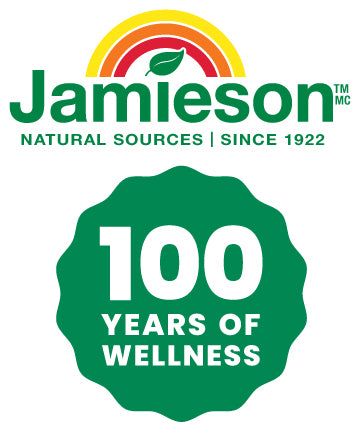It’s that time of the year… pack away the boots and jackets, put away the winter tires, but think twice before letting your winter vitamin D supplement hide at the back of the cabinet! Yes, that’s right. You still need vitamin D during the summer.
One of the biggest misconceptions is that soaking up the summer sun can satisfy our body’s vitamin D needs.
Vitamin D is an essential fat-soluble vitamin that plays an important role in practically every system in the body. Vitamin D is vital in maintaining strong bones and a healthy immune system.1,2 One of the two main ways of getting enough Vitamin D is through food, which can be very difficult. In fact, the only natural food sources are fatty fish3, egg yolks4 and mushrooms5.
Another method of getting vitamin D is through the sun. When sun shines on our skin, it triggers a series of chemical processes that lead to more vitamin D in our body! But before you go and soak up all that summer sun, it is important to understand the risks associated with too much sun exposure and factors that limit vitamin D absorption.
Exposure to sun and its harmful UV rays is the leading cause of skin cancer in Canada. UV rays can cause sunburns, premature aging, and skin cancers.6 In fact, the ComPARe study conducted by the Canadian Cancer Society in 2014 identified sun exposure and indoor tanning as the two most common causes of skin cancer.7 At least 62% of diagnosed cases could have been prevented by limiting UV exposure.7 Skin cancer from too much sun exposure is on the rise. At the current rate, the number of melanoma cases from UV radiation could increase from 4,300 to 6,100 by 2042 if Canadians continue tanning their skin and getting painful sunburns.7 Although using sunscreen can protect against skin cancer, it also prevents the body from synthesizing vitamin D optimally.
Skin tone is another important factor to consider when thinking about how much vitamin D can be absorbed by the skin. Melanin, the chemical that provides skin pigmentation also doubles as a protector against UV rays.8 Although this means less chances of getting skin cancer, it also means less vitamin D synthesis.8 We know that it is common for some individuals to be deficient in vitamin D, but the prevalence of vitamin D deficiency is even higher for individuals who come from different ethnic backgrounds.9 While 40% of American adults are deficient in vitamin D, this number jumps to 76% in the African American population.9 Even in Canada, darker skin toned individuals have lower levels of vitamin D.10
An easy, effective and skin-safe way of getting optimal levels of vitamin D is through Jamieson’s new Vitamin D 2,500 IU. It is Canada’s first high potency vitamin D available as a natural health product for self-selection! Just one tablet daily helps to prevent vitamin D deficiency.11
References:
1. Vitamin D Deficiency: Symptoms & Treatment. Cleveland Clinic. (n.d.). https://my.clevelandclinic.org/health/articles/15050-vitamin-d--vitamin-d-deficiency.
2. Hormone. (2019, June 17). Vitamin D. Hormone Health Network. https://www.hormone.org/your-health-and-hormones/glands-and-hormones-a-to-z/hormones/vitamin-d.
3. Vitamin D. Office of Dietary Supplement. National institutes of Health. Accessed online June 10th, 2021. https://ods.od.nih.gov/factsheets/VitaminD-Consumer/
4. Linus Pauling Institute Micronutrient Information Centre. Vitamin D. Accessed June 10th, 2021 at: https://lpi.oregonstate.edu/mic/vitamins/vitamin-D
5. Mushrooms Canada. Commercialization of Vitamin D Enhanced Mushrooms by UV Light Treatment. Accessed June 10th, 2021 at: https://www.mushrooms.ca/wp-content/uploads/2016/01/Commercialization-of-Vitamin-D-Enhanced-Mushrooms.pdf
6. Sunscreen. The Skin Cancer Foundation. (2021, May 28). https://www.skincancer.org/skin-cancer-prevention/sun-protection/sunscreen/.
7. ComPARe study on preventable cancers in Canada. ComPARe. (2020, December 23). https://prevent.cancer.ca/.
8. Webb, A., Kazantzidis, A., Kift, R., Farrar, M., Wilkinson, J., & Rhodes, L. (2018). Colour Counts: Sunlight and Skin Type as Drivers of Vitamin D Deficiency at UK Latitudes. Nutrients, 10(4), 457. https://doi.org/10.3390/nu10040457
9. African-Americans At Greatest Risk of Vitamin D Deficiency - Cooper Institute. The Cooper Institute. (n.d.). https://www.cooperinstitute.org/2019/09/24/african-americans-at-greatest-risk-of-vitamin-d-deficiency.
10. Brown, L. V. L., Cohen, B., Tabor, D., Zappalà, G., Maruvada, P., & Coates, P. M. (2018). The vitamin D paradox in Black Americans: a systems-based approach to investigating clinical practice, research, and public health - expert panel meeting report. BMC Proceedings, 12(S6). https://doi.org/10.1186/s12919-018-0102-4
11. Government of Canada. Product information. Accessed on June 15th, 2021 at https://health-products.canada.ca/lnhpd-bdpsnh/info.do?licence=80108995




